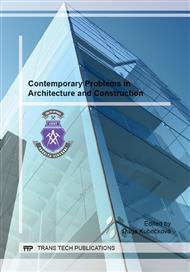p.221
p.227
p.233
p.238
p.242
p.248
p.253
p.258
p.264
Investigations of RC Shear Wall-Frame Structures with Various Openings in Walls under Earthquake Loading
Abstract:
Almost all high-rise buildings have been constructed in the Republic of Armenia for past twenty-five years are Reinforced Concrete (RC) shear wall–frame structures, where shear walls provide most of the stiffness of buildings. The walls in these buildings are designed to sustain earthquake and wind loads. Vulnerability of them during earthquake action depends on many different factors. Some of them are the openings and its location in the walls. Usage of ground stories as parking and garages is demanded large openings in shear walls therefore determination of ultimate sizes of openings is important problems for designers. In this paper, FEM (Finite Element Method) models are used for investigation of stress-strain state of RC wall–frame buildings with various openings in the walls under action of seismic forces. Limitation of size and position of openings are considered in the paper taking into account of building code of Armenia. Various schemes of openings are considered in the article. The existing experimental data of shear walls were performed in various laboratories have been compared with our numerical investigation of RC models based on nonlinear computer analyses. Dynamic analyses of structures using accelerograms are showed sequence of damages in RC wall-frame models. The recommendations for limitation of ratio area of an opening to the whole area of a wall are proposed at the end of the article.
Info:
Periodical:
Pages:
242-247
Citation:
Online since:
October 2014
Authors:
Keywords:
Price:
Сopyright:
© 2014 Trans Tech Publications Ltd. All Rights Reserved
Share:
Citation:


